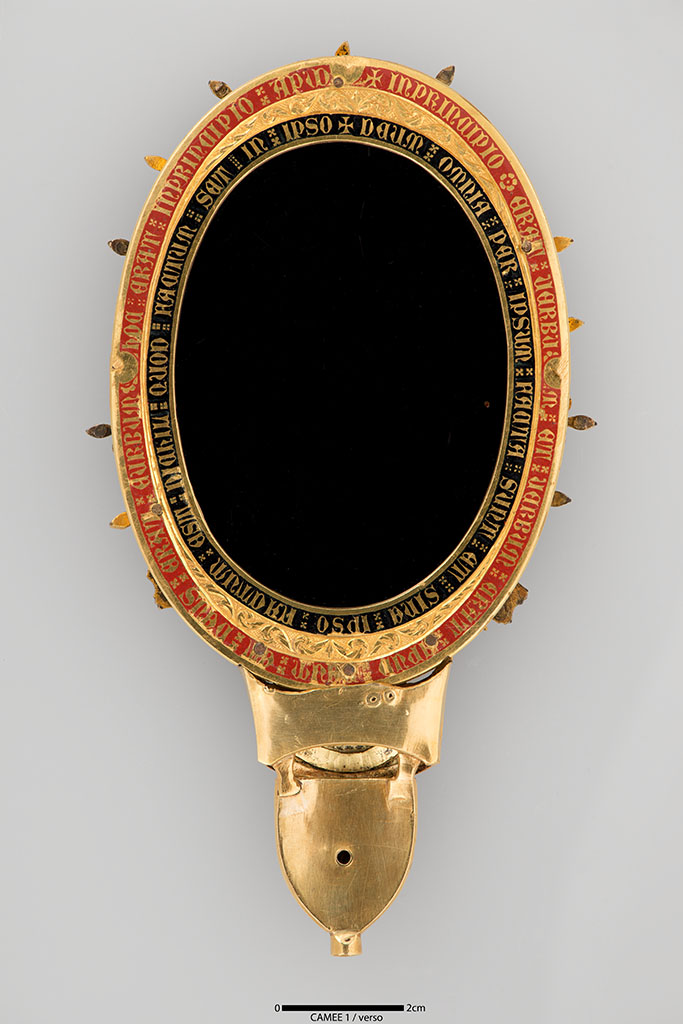Object History and Significance: The Cameo of Jupiter (Chartres)
The current exhibition Devotion and Decadence features many remarkable archaeological finds, but some masterpieces of ancient art were consistently saved as luxury objects from the time of their creation. Cameos, for example, were frequently preserved and passed through different collections from the ancient world to the present. In the case of the Cameo of Jupiter (The Cameo of Chartres), its fourteenth-century mount tells us something about the object’s history as well as its changing significance over time.
Jupiter—seen here with a scepter, thunderbolt, and eagle as signs of his power—was a common figure in Roman glyptic art. But the quality of the sardonyx stone and the astonishing detail of its carving make this an exceptional example of the god’s representation. Originally created in the first century CE, the cameo was conserved throughout antiquity and the Byzantine period in the imperial treasury, traveling from Rome to Constantinople in the early fourth century, and then likely taken back west again during the Crusades. It was probably around this time when Constantinople was plundered by the Crusaders in 1204, that the cameo entered the collection of European churches and princes.

This piece eventually came into the hands of Charles V of France (1338–1380), a great collector of jewels, engraved stones, and cameos. The mount dates to around his time, and its front is decorated with passages from the Gospels of Luke (4:30) and John (7:2). Sometimes found together on magical amulets—these verses describe Christ’s safe passage amid his enemies—this biblical decoration was believed to confer protective powers on the artifact’s bearer. The text in enameled gold on the mount’s back border is the opening of the Gospel of John, also believed to provide safety. The presence of these verses enhances the identification of Jupiter with John the Evangelist, as an eagle was the companion of both. The cameo has a telling inscription above its fleur-de-lis escutcheon: “Charles King of France, son of King John, gave this jewel in the year 1367.” After losing his first four children, Charles V made a pilgrimage to Chartres to ask for an heir and donated the cameo to the cathedral’s reliquary. In 1578 the cameo was seized from by Henri III but was later returned to Chartres.
In 1793, during the French Revolution, the reliquary of Chartres was melted down for the value of its precious metals, and valuable stones were sold, yet this cameo was sent to the Cabinet de médailles. Abbé Barthélemy, “keeper” (curator) of the Cabinet from 1753 to 1795, actually grew the collection during the French Revolution: Barthélemy fought to preserve both sacred and secular cultural history, bringing many objects into the collection of his care. By the end of the Revolution, the Cabinet became the Musée des Antiques, the first major center for archaeology in France, with a focus on training future historians of the ancient world. Today, the Cabinet de médailles is part of the collection of the Bibliothèque nationale de France.
Cameo of Jupiter (The Cameo of Chartres) Set in Fourteenth-Century Mount
Roman, ca. 50 CE
Mounted in Paris
Sardonyx; gold and enamel mount
H. 15.2 cm; L. 6.5 cm
Bibliothèque nationale de France, Paris: Camée.1